Structural and Conformational Studies on Carboxamides of 5,6-Diaminouracils—Precursors of Biologically Active Xanthine Derivatives
Abstract
1. Introduction
2. Results and Discussion
2.1. Chemistry
2.2. Analytical Studies
2.2.1. Dynamic NMR Experiments of 8a at High Temperatures
2.2.2. Two-Dimensional NMR Studies
2.2.3. Analysis of Differently Substituted 5-Amino-6-Carboxamidouracil Derivatives
2.2.4. NMR Studies at Low Temperature
2.2.5. DFT Calculations
2.2.6. X-ray Crystal Structure
3. Conclusions
4. Materials and Methods
4.1. Eyring Equation
4.2. DFT Calculation
4.3. General Procedures
4.3.1. Synthesis of 5,6-Diaminouracil Derivatives
4.3.2. General Procedure for Amide Formation
4.3.3. NMR Spectra
Supplementary Materials
Author Contributions
Funding
Acknowledgments
Conflicts of Interest
References
- Boison, D. Adenosine as a neuromodulator in neurological diseases. Curr. Opin. Pharmacol. 2008, 8, 2–7. [Google Scholar] [CrossRef] [PubMed]
- Morelli, M.; Carta, A.R.; Jenner, P. Adenosine A2A receptors and Parkinson’s disease. Handb. Exp. Pharmacol. 2009, 193, 589–615. [Google Scholar]
- Rahman, A. The role of adenosine in Alzheimer’s disease. Curr. Neuropharmacol. 2009, 7, 207–216. [Google Scholar] [CrossRef] [PubMed]
- Leone, R.D.; Lo, Y.-C.; Powell, J.D. A2AR antagonists: Next generation checkpoint blockade for cancer immunotherapy. Comput. Struct. Biotechnol. J. 2015, 13, 265–272. [Google Scholar] [CrossRef] [PubMed]
- Franco, R.; Oñatibia-Astibia, A.; Martínez-Pinilla, E. Health benefits of methylxanthines in cacao and chocolate. Nutrients 2013, 5, 4159–4173. [Google Scholar] [CrossRef] [PubMed]
- Dungo, R.; Deeks, E.D. Istradefylline: First global approval. Drugs 2013, 73, 875–882. [Google Scholar] [CrossRef] [PubMed]
- LeWitt, P.A.; Guttman, M.; Tetrud, J.W.; Tuite, P.J.; Mori, A.; Chaikin, P.; Sussman, N.M. Adenosine A2A receptor antagonist istradefylline (KW-6002) reduces “off” time in Parkinsons disease: A double-blind, randomized, multicenter clinical trial (6002-US-005). Ann. Neurol. 2008, 63, 295–302. [Google Scholar] [CrossRef]
- Sauer, R.; Maurinsh, J.; Reith, U.; Fülle, F.; Klotz, K.-N.; Müller, C.E. Water-soluble phosphate prodrugs of 1-propargyl-8-styrylxanthine derivatives, A2A-selective adenosine receptor antagonists. J. Med. Chem. 2000, 43, 440–448. [Google Scholar] [CrossRef]
- Hockemeyer, J.; Burbiel, J.C.; Müller, C.E. Multigram-scale syntheses, stability, and photoreactions of A2A adenosine receptor antagonists with 8-styrylxanthine structure: potential drugs for Parkinson’s Disease. J. Org. Chem. 2004, 69, 3308–3318. [Google Scholar] [CrossRef]
- Müller, C.E.; Schobert, U.; Hipp, J.; Geis, U.; Frobenius, W.; Pawlowski, M. Configurationally stable analogs of styrylxanthines as A2A adenosine receptor antagonist. Eur. J. Med. Chem. 1997, 32, 709–719. [Google Scholar] [CrossRef]
- Müller, C.E.; Hockemeyer, J.; Tzvetkov, N.; Burbiel, J.C. 8-Ethinylxanthine Derivatives as Selective A2A Receptor Antagonists. WO Patent WO2008077557A1, 19 December 2007. [Google Scholar]
- Lopes, B.A.; Miguez, E.; Kümmerle, E.A.; Rumjanek, M.V.; Fraga, A.C.; Barreiro, J.E. Characterization of amide bond conformers for a novel heterocyclic template of N-acylhydrazone derivatives. Molecules 2013, 18, 11683–11704. [Google Scholar] [CrossRef] [PubMed]
- Quintanilla-Licea, R.; Colunga-Valladares, J.; Caballero-Quintero, A.; Rodríguez-Padilla, C.; Tamez-Guerra, R.; Gomez-Flores, R.; Waksman, N. NMR detection of isomers arising from restricted rotation of the C-N amide bond of N-formyl-o-toluidine and N,N-bis-formyl-o-tolidine. Molecules 2002, 7, 662–673. [Google Scholar] [CrossRef]
- Mphahlele, J.M.; Maluleka, M.M.; Rhyman, L.; Ramasami, P.; Mampa, M.R. Spectroscopic, DFT, and XRD studies of hydrogen bonds in N-unsubstituted 2-aminobenzamides. Molecules 2017, 22, 83. [Google Scholar] [CrossRef] [PubMed]
- Laursen, J.S.; Engel-Andreasen, J.; Fristrup, P.; Harris, P.; Olsen, C.A. Cis-trans amide bond rotamers in beta-peptoids and peptoids: Revaluation of stereoelectronic effects in backbone and side chains. J. Am. Chem. Soc. 2013, 135, 2835–2844. [Google Scholar] [CrossRef] [PubMed]
- Hu, X.; Zhang, W.; Carmichael, I.; Serianni, A.S. Amide cis−trans iosomerization in aqueous solutions of methyl N-formyl-d-glucosaminides and methyl N-acetyl-d-glucosaminides: Chemical equilibria and exchange kinetics. J. Am. Chem. Soc. 2010, 132, 4641–4652. [Google Scholar] [CrossRef]
- Marx, D.; Wingen, L.M.; Schnakenburg, G.; Müller, C.E.; Scholz, M.S. Fast, efficient, and versatile synthesis of 6-amino-5-carboxamidouracils as precursors for 8-substituted xanthines. Front. Chem. 2019, 7, 1–15. [Google Scholar] [CrossRef]
- El-Sabbagh, O.I.; El-Sadek, M.E.; El-Kalyoubi, S.; Ismail, I. Synthesis, DNA binding and antiviral activity of new uracil, xanthine, and pteridine derivatives. Arch. Pharm. 2007, 340, 26–31. [Google Scholar] [CrossRef]
- Hayallah, A.M.; Sandoval-Ramírez, J.; Reith, U.; Schobert, U.; Preiss, B.; Schumacher, B.; Daly, J.W.; Müller, C.E. 1,8-Disubstituted xanthine derivatives: Synthesis of potent A2B-selective adenosine receptor antagonists. J. Med. Chem. 2002, 45, 1500–1510. [Google Scholar] [CrossRef]
- Yang, S.-M.; Yasgar, A.; Miller, B.; Lal-Nag, M.; Brimacombe, K.; Hu, X.; Sun, H.; Wang, A.; Xu, X.; Nguyen, K.; et al. Discovery of NCT-501, a potent and selective theophylline-based inhibitor of aldehyde dehydrogenase 1A1 (ALDH1A1). J. Med. Chem. 2015, 58, 5967–5978. [Google Scholar] [CrossRef]
- Poulsen, A.; Ho, S.Y.; Wang, W.; Alam, J.; Jeyaraj, D.A.; Ang, S.H.; Tan, E.S.W.; Lin, G.R.; Cheong, V.W.W.; Ke, Z.; et al. Pharmacophore model for Wnt/Porcupine inhibitors and its use in drug design. J. Chem. Inf. Model. 2015, 55, 1435–1448. [Google Scholar] [CrossRef] [PubMed]
- Novak, P.; Skare, D.; Sekušak, S.; Vikić-Topić, D. Substituent, temperature and solvent effects on keto-enol equilibrium in symmetrical pentane-1,3,5-triones. Nuclear magnetic resonance and theoretical studies. Croatica Chemica Acta 2000, 73, 1153–1170. [Google Scholar]
- Krishnan, V.V.; Thompson, W.B.; Goto, J.J.; Maitra, K.; Maitra, S. Modulations in restricted amide rotation by steric induced conformational trapping. Chem. Phys. Lett. 2012, 523, 124–127. [Google Scholar] [CrossRef] [PubMed]
- Gorse, A.-D.; Pesquer, M. A theoretical study of aniline and some derivatives in their ground states. J. Mol. Struct. Theochem. 1993, 281, 21–32. [Google Scholar] [CrossRef]
- Gasparro, F.P.; Kolodny, N.H. NMR determination of the rotational barrier in N,N-dimethylacetamide. A physical chemistry experiment. J. Chem. Educ. 1977, 54, 258. [Google Scholar] [CrossRef]
- Mamat, C.; Pretze, M.; Gott, M.; Köckerling, M. Synthesis, dynamic NMR characterization and XRD studies of novel N,N’-substituted piperazines for bioorthogonal labeling. Beilstein J. Org. Chem. 2016, 12, 2478–2489. [Google Scholar] [CrossRef]
- Modarresi-Alam, A.R.; Najafi, P.; Rostamizadeh, M.; Keykha, H.; Bijanzadeh, H.-R.; Kleinpeter, E. Dynamic 1H NMR Study of the barrier to rotation about the C−N bond in primary carbamates and its solvent dependence. J. Org. Chem. 2007, 72, 2208–2211. [Google Scholar] [CrossRef]
- Stærk, D.; Norrby, P.-O.; Jaroszewski, J.W. Conformational analysis of indole alkaloids corynantheine and dihydrocorynantheine by dynamic 1H NMR spectroscopy and computational methods: steric effects of ethyl vs vinyl group. J. Org. Chem. 2001, 66, 2217–2221. [Google Scholar] [CrossRef]
- Ahlrichs, R.; Bär, M.; Häser, M.; Horn, H.; Kölmel, C. Electronic structure calculations on workstation computers: The program system turbomole. Chem. Phys. Lett. 1989, 162, 165–169. [Google Scholar] [CrossRef]
- Neese, F. ORCA—An ab Initio, DFT and Semiempirical SCF-MO Package; Max Planck Institute for Bioinorganic Chemistry: Mülheim an der Ruhr, Germany, 2012. [Google Scholar]
- Grimme, S.; Brandenburg, J.G.; Bannwarth, C.; Hansen, A. Consistent structures and interactions by density functional theory with small atomic orbital basis sets. J. Chem. Phys. 2015, 143, 054107. [Google Scholar] [CrossRef]
- Grimme, S.; Bannwarth, C.; Dohm, S.; Hansen, A.; Pisarek, J.; Pracht, P.; Seibert, J.; Neese, F. Fully automated quantum-chemistry-based computation of spin-spin-coupled nuclear magnetic resonance spectra. Angew. Chem. Int. Ed. Engl. 2017, 56, 14763–14769. [Google Scholar] [CrossRef] [PubMed]
- Grimme, S.; Bannwarth, C.; Shushkov, P. A robust and accurate tight-binding quantum chemical method for structures, vibrational frequencies, and noncovalent interactions of large molecular systems parametrized for all spd-block elements (Z = 1–86). J. Chem. Theory Comput. 2017, 13, 1989–2009. [Google Scholar] [CrossRef] [PubMed]
- Zimmerman, P. Reliable transition state searches integrated with the growing string method. J. Chem. Theory Comput. 2013, 9, 3043–3050. [Google Scholar] [CrossRef] [PubMed]
- Grimme, S. XTB, a Tight-Binding Quantum Chemistry Code for Large Molecules, version 6.1; University of Bonn: Bonn, Germany, 2019. [Google Scholar]
- Weigend, F.; Ahlrichs, R. Balanced basis sets of split valence, triple zeta valence and quadruple zeta valence quality for H to Rn: Design and assessment of accuracy. Phys. Chem. Chem. Phys. 2005, 7, 3297–3305. [Google Scholar] [CrossRef] [PubMed]
- Kozuch, S.; Gruzman, D.; Martin, J.M.L. DSD-BLYP: A general purpose double hybrid density functional including spin component scaling and dispersion correction. J. Phys. Chem. C 2010, 114, 20801–20808. [Google Scholar] [CrossRef]
- Grimme, S.; Antony, J.; Ehrlich, S.; Krieg, H. A consistent and accurate ab initio parametrization of density functional dispersion correction (DFT-D) for the 94 elements H-Pu. J. Chem. Phys. 2010, 132, 154104. [Google Scholar] [CrossRef]
- Kozuch, S.; Martin, J.M.L. Spin-component-scaled double hybrids: An extensive search for the best fifth-rung functionals blending DFT and perturbation theory. J. Comput. Chem. 2013, 34, 2327–2344. [Google Scholar] [CrossRef]
- Goerigk, L.; Hansen, A.; Bauer, C.; Ehrlich, S.; Najibi, A.; Grimme, S. A look at the density functional theory zoo with the advanced GMTKN55 database for general main group thermochemistry, kinetics and noncovalent interactions. Phys. Chem. Chem. Phys. 2017, 19, 32184–32215. [Google Scholar] [CrossRef]
- Eichkorn, K.; Treutler, O.; Öhm, H.; Häser, M.; Ahlrichs, R. Auxiliary basis sets to approximate coulomb potentials. Chem. Phys. Lett. 1995, 240, 283–290. [Google Scholar] [CrossRef]
- Grimme, S. Supramolecular binding thermodynamics by dispersion-corrected density functional theory. Chem. - Eur. J. 2012, 18, 9955–9964. [Google Scholar] [CrossRef]
- Sure, R.; Grimme, S. Corrected small basis set Hartree-Fock method for large systems. J. Comput. Chem. 2013, 34, 1672–1685. [Google Scholar] [CrossRef] [PubMed]
- Eckert, F.; Klamt, A. Fast solvent screening via quantum chemistry: COSMO-RS approach. AIChE J. 2004, 48, 369–385. [Google Scholar] [CrossRef]
- Becke, A.D. Density-functional exchange-energy approximation with correct asymptotic behavior. Phys. Rev. A Gen. Phys. 1988, 38, 3098–3100. [Google Scholar] [CrossRef] [PubMed]
- Sinnecker, S.; Rajendran, A.; Klamt, A.; Diedenhofen, M.; Neese, F. Calculation of solvent shifts on electronic g-tensors with the conductor-like screening model (COSMO) and its self-consistent generalization to real solvents (direct COSMO-RS). J. Phys. Chem. A 2006, 110, 2235–2245. [Google Scholar] [CrossRef] [PubMed]
Sample Availability: Samples of compound 8a are available from the authors. |

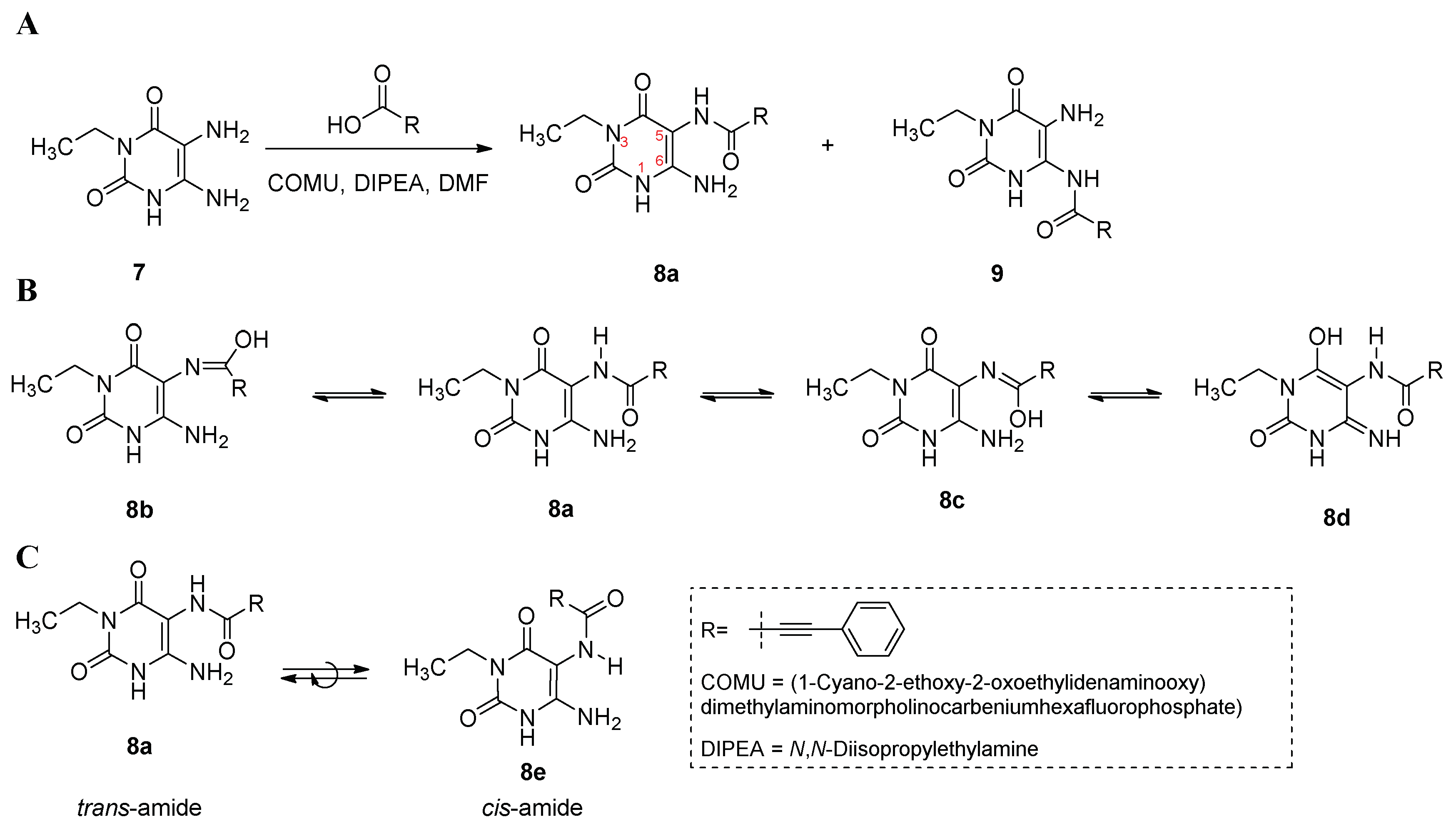



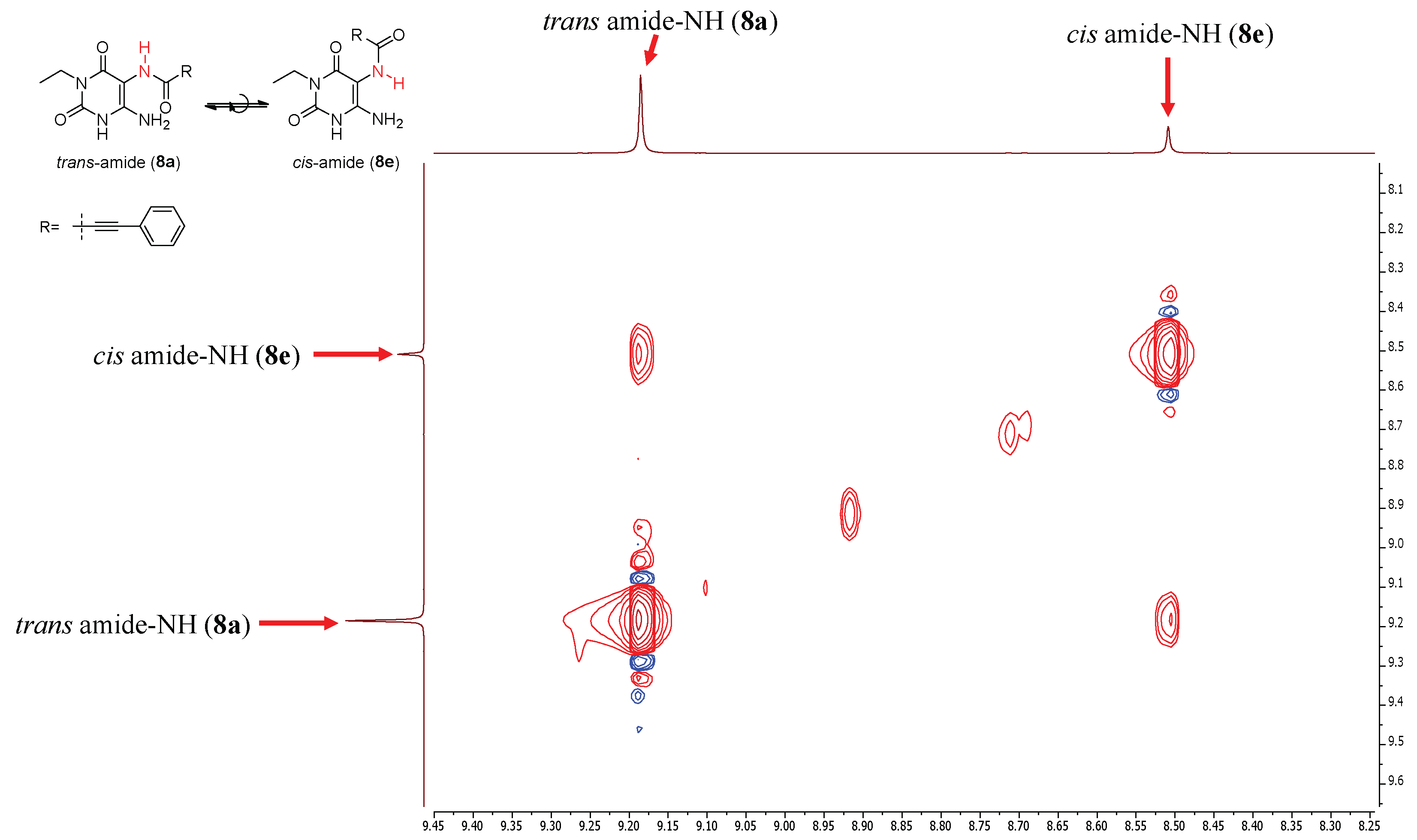
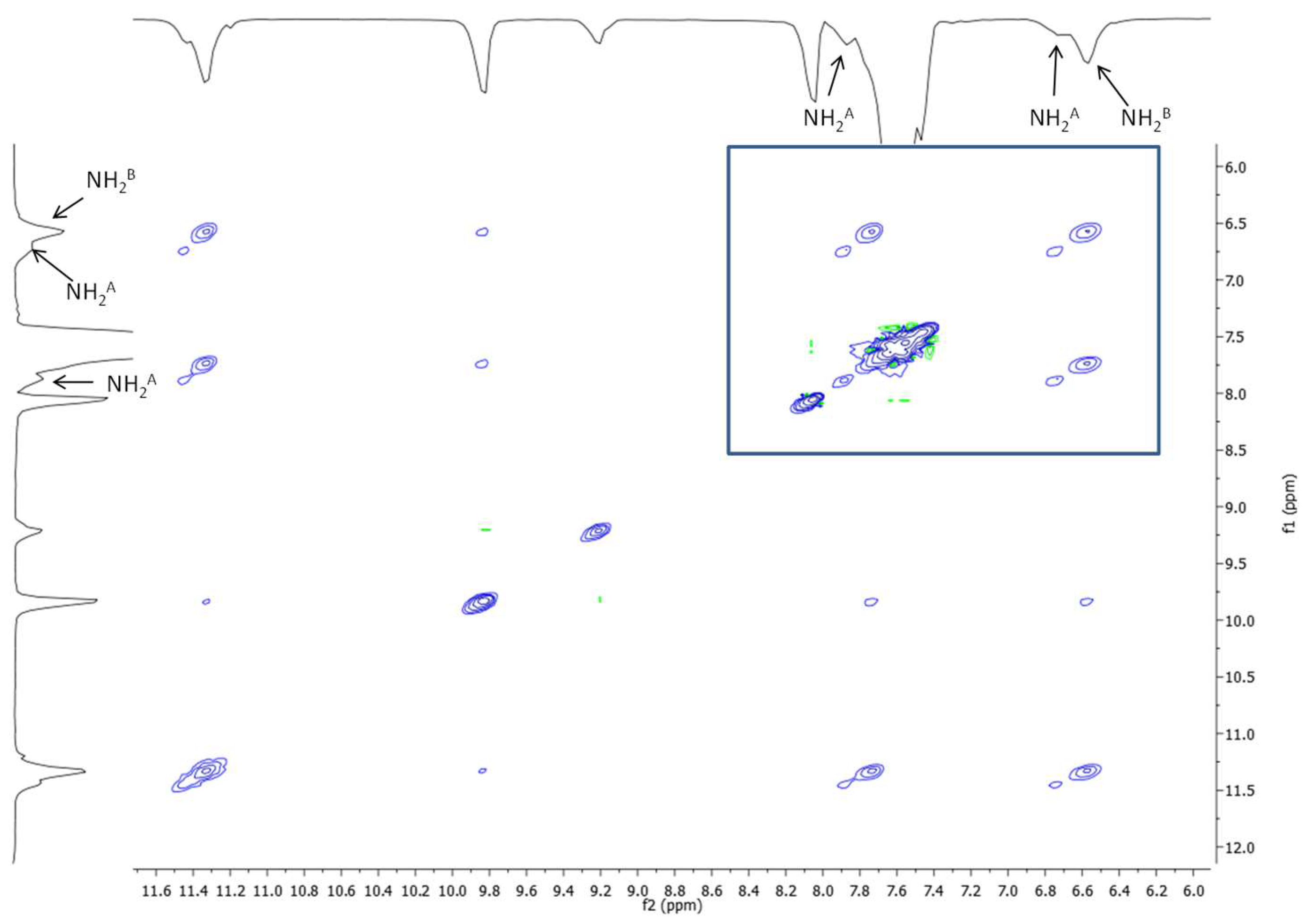

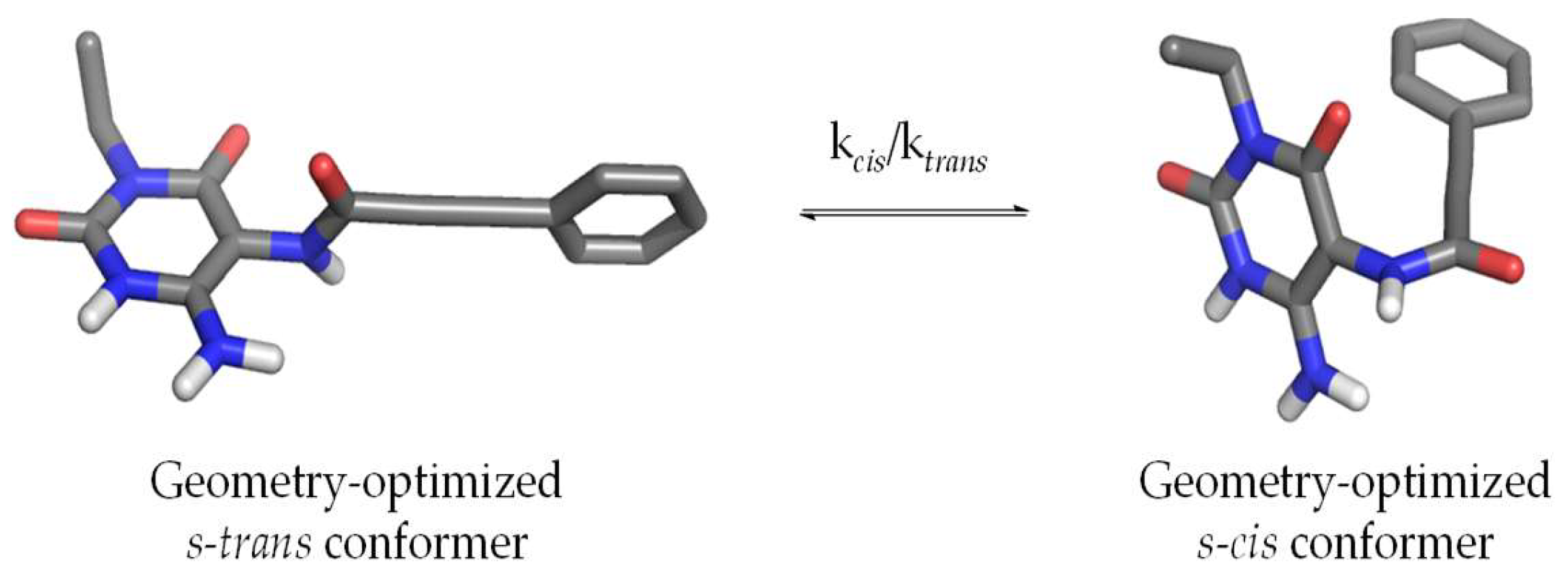
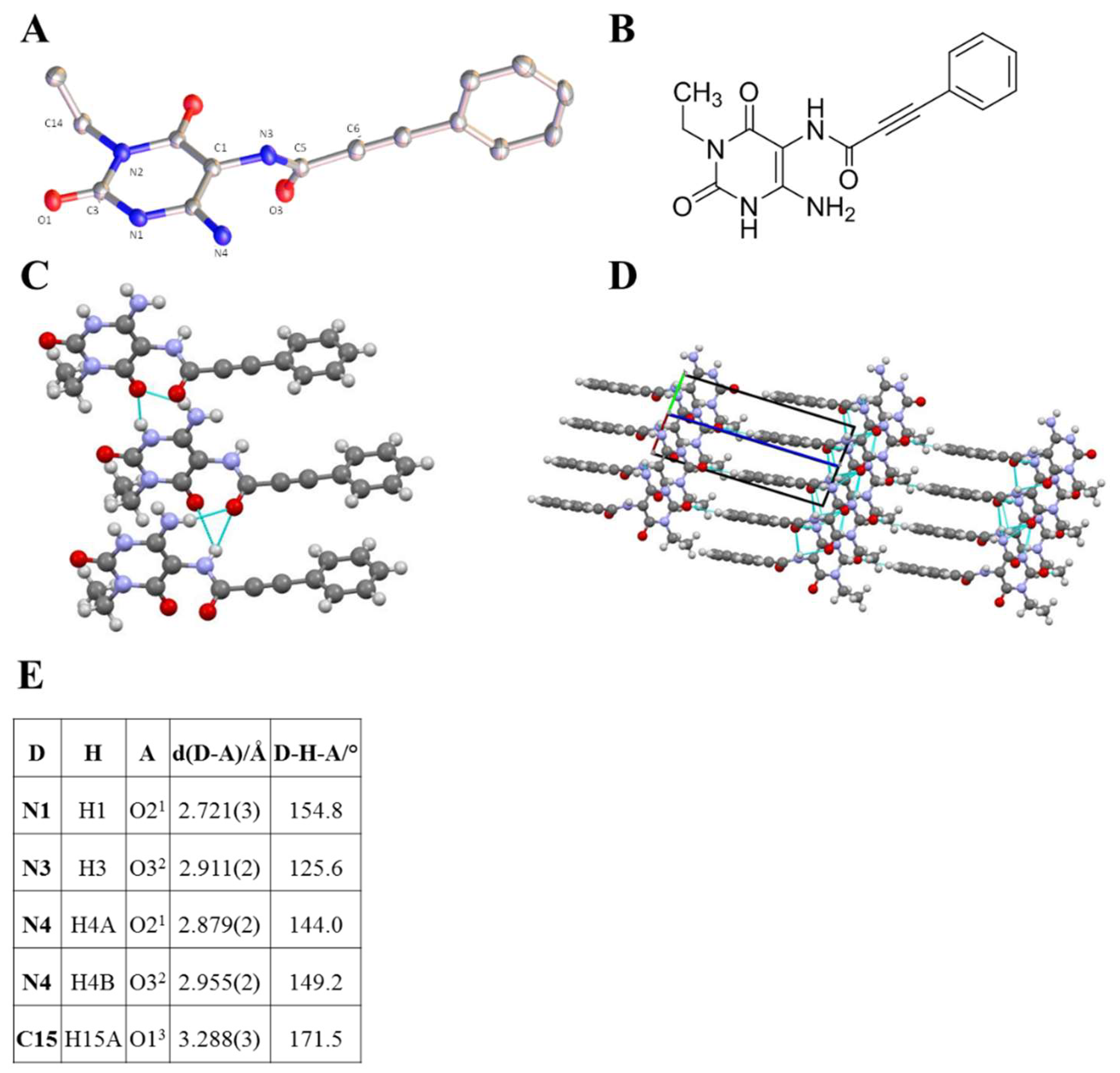
| Compound | Structure | Yield a | trans/cis % Ratio b |
|---|---|---|---|
| 8a |  | 85% | 73:27 |
| 12 |  | 79% | 72:28 |
| 13 | 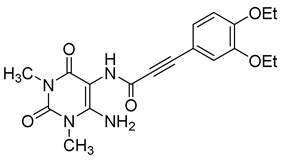 | 88% | 77:23 |
| 14 |  | 80% | 95:5 |
| 15 |  | 90% | 89:11 |
| 16 |  | 87% | 100:0 |
| 17 |  | 80% | 91:9 |
© 2019 by the authors. Licensee MDPI, Basel, Switzerland. This article is an open access article distributed under the terms and conditions of the Creative Commons Attribution (CC BY) license (http://creativecommons.org/licenses/by/4.0/).
Share and Cite
Marx, D.; Schnakenburg, G.; Grimme, S.; Müller, C.E. Structural and Conformational Studies on Carboxamides of 5,6-Diaminouracils—Precursors of Biologically Active Xanthine Derivatives. Molecules 2019, 24, 2168. https://doi.org/10.3390/molecules24112168
Marx D, Schnakenburg G, Grimme S, Müller CE. Structural and Conformational Studies on Carboxamides of 5,6-Diaminouracils—Precursors of Biologically Active Xanthine Derivatives. Molecules. 2019; 24(11):2168. https://doi.org/10.3390/molecules24112168
Chicago/Turabian StyleMarx, Daniel, Gregor Schnakenburg, Stefan Grimme, and Christa E. Müller. 2019. "Structural and Conformational Studies on Carboxamides of 5,6-Diaminouracils—Precursors of Biologically Active Xanthine Derivatives" Molecules 24, no. 11: 2168. https://doi.org/10.3390/molecules24112168
APA StyleMarx, D., Schnakenburg, G., Grimme, S., & Müller, C. E. (2019). Structural and Conformational Studies on Carboxamides of 5,6-Diaminouracils—Precursors of Biologically Active Xanthine Derivatives. Molecules, 24(11), 2168. https://doi.org/10.3390/molecules24112168






